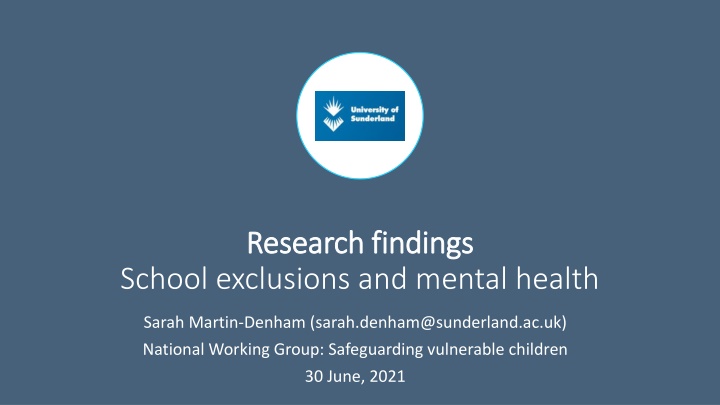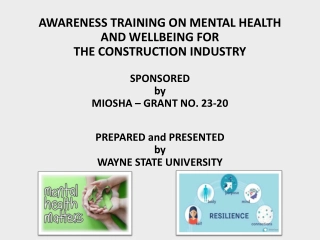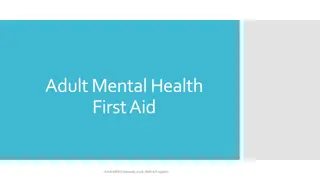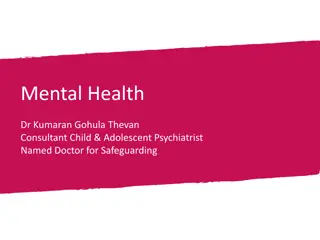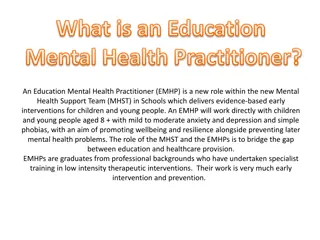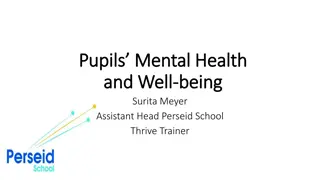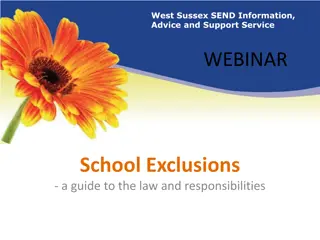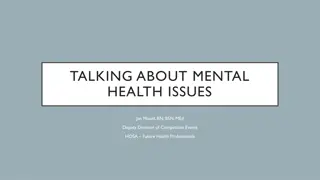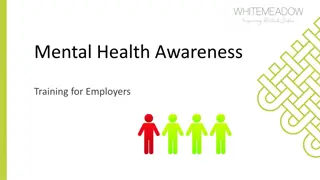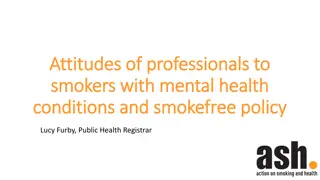School Exclusions and Mental Health Impact: Research Findings
This research delves into the factors influencing the social and emotional well-being of children in Sunderland, potentially leading to school exclusion. It aims to uncover perceptions of excluded children, caregivers, and professionals, exploring barriers and enablers to mainstream schooling, impact of exclusion on families, and reasons driving school exclusion.
Download Presentation

Please find below an Image/Link to download the presentation.
The content on the website is provided AS IS for your information and personal use only. It may not be sold, licensed, or shared on other websites without obtaining consent from the author.If you encounter any issues during the download, it is possible that the publisher has removed the file from their server.
You are allowed to download the files provided on this website for personal or commercial use, subject to the condition that they are used lawfully. All files are the property of their respective owners.
The content on the website is provided AS IS for your information and personal use only. It may not be sold, licensed, or shared on other websites without obtaining consent from the author.
E N D
Presentation Transcript
Research findings Research findings School exclusions and mental health Sarah Martin-Denham (sarah.denham@sunderland.ac.uk) National Working Group: Safeguarding vulnerable children 30 June, 2021
Evidence base (sure.sunderland.ac.uk) Evidence base (sure.sunderland.ac.uk) 1Martin-Denham, S. (2020a) The enablers and barriers to successful managed moves: The voice of children, caregivers and professionals https://sure.sunderland.ac.uk/id/eprint/11942/ 5Martin-Denham, S. (2021) School exclusion, substance misuse and use of weapons: An interpretative phenomenological analysis of interviews with children. (Accepted) Support for Learning. 6Martin-Denham, S. (2020) Riding the roller coaster of school exclusion coupled with drug misuse: The lived experience of caregivers. Emotional and Behavioural Difficulties. DOI: 10.1080/13632752.2020.1848985 2Martin-Denham, S. (2020b) An investigation into the perceived enablers and barriers to mainstream schooling: The voices of children excluded from school, their caregivers and professionals https://sure.sunderland.ac.uk/id/eprint/11941/ 7Martin-Denham, S. and Donaghue, J. (2020) Out of sight, out of mind? Managed moves in England. Sunderland: University of Sunderland. https://sure.sunderland.ac.uk/id/eprint/11883/ 3Martin-Denham, S. (2020c) A review of school exclusion on the mental health, well-being of children and young people in the City of Sunderland https://sure.sunderland.ac.uk/id/eprint/11940/ 8Martin-Denham, S. and Donaghue, J. (2020) Excluded for no real reason. Sunderland: University of Sunderland. https://sure.sunderland.ac.uk/id/eprint/11472/ 4Martin-Denham, S. and Donaghue, J. (2020) Impact and Measure of Adverse Childhood Experiences, Journal of Public Health https://rdcu.be/b68MO 9Martin-Denham, S. (2021) The road to school exclusion: An interpretative phenomenological analysis of interviews with parents of children with autism in the UK. (In review Autism )
Aims and objectives of the research: Aims and objectives of the research: Funded by Together for Children Funded by Together for Children Aim: To investigate the factors that impact upon social and emotional wellbeing of children and young people from 3-16 years in Sunderland which may lead to exclusion from school. Key objectives: To elicit the perceptions and experiences of excluded children, their caregivers and professionals of the barriers and enablers to mainstream schooling To determine if it is possible for children at risk of school exclusion to feel and be included while attending mainstream school To establish the impact of school exclusion on the child and family To determine the drivers for school exclusion
Group Children KS1 KS2/3 KS4 Caregivers KS1 KS2/3 KS4 Professionals Nursery headteachers Primary headteachers Secondary headteachers Specialist headteachers ARP/AP headteachers SENCO Count 55 20 15 20 41 4 16 21 78 4 28 9 4 10 14 Sample 32% 11% 9% 11% 24% 2% 9% 12% 45% 2% 16% 5% 2% 6% 8% Sample: Sample: Participant Participant overview overview 174 children, caregivers and professionals interviewed. In addition, there were three advisory groups, 12 children, five professionals from health/support services and five education professionals. This is the most substantial piece of primary research carried out to date on the enablers and barriers to mainstream schooling for those at risk of school exclusion in England. Health and support Total 9 5% 174
Total in Sunderland 8 62 18 7 6 Sample Candidates 4 28 10 4 4 % Type of School Mainstream Nursery Mainstream Primary Mainstream Secondary Special School Alternative Provision Additional Resourced Provision Total Sampled 50% 45% 56% 57% 67% Proportion of Proportion of Sunderland schools Sunderland schools interviewed interviewed 15 116 3 53 20% 46%
Methodology Methodology Mixed methods including content (interpreting and understanding) and interpretative phenomenological analysis (IPA) (Smith and Osborn, 2015). The interviews were suitable for IPA as they included rich detail with novel stories and language (Riley et al., 2017; Spiers et al., 2017; Spiers and Riley, 2019; Smith et al., 2009) A two-stage process or double hermeneutic was used, where the participant makes sense of their world and the researcher, in an active role, attempts to authentically make sense of their experiences (Colaizzi, 1978; Giorgi, 1985; Smith and Eatough,2007; van Manen, 2014 (Harding, 2019)
Safeguarding (DfE, 2020) Safeguarding and promoting the welfare of children is everyone s responsibility. In order to fulfil this responsibility effectively, all practitioners should make sure their approach is child-centred. They should consider, what is in the best interests of the child (p.5). Safeguarding and promoting the welfare of children is defined for the purposes of this guidance as: protecting children from maltreatment; preventing impairment of children s mental and physical health or development; ensuring that children grow up in circumstances consistent with the provision of safe and effective care; and taking action to enable all children to have the best outcomes.
Emotional abuse: the persistent emotional maltreatment of a child such as to cause severe and adverse effects on the child s emotional development. It may involve conveying to a child that they are worthless or unloved, inadequate, or valued only insofar as they meet the needs of another person. It may include not giving the child opportunities to express their views, deliberately silencing them or making fun of what they say or how they communicate. It may feature age or developmentally inappropriate expectations being imposed on children. These may include interactions that are beyond a child s developmental capability as well as overprotection and limitation of exploration and learning, or preventing the child from participating in normal social interaction. It may involve seeing or hearing the ill-treatment of another. It may involve serious bullying (including cyberbullying), causing children frequently to feel frightened or in danger, or the exploitation or corruption of children. Some level of emotional abuse is involved in all types of maltreatment of a child, although it may occur alone. DfE 2020, p. 8-9 Keeping children safe in education (2020) Statutory guidance for schools and colleges
What are the factors associated with teacher and pupil wellbeing, and what interventions and approaches are effective in supporting and promoting wellbeing of all in schools and colleges? What types of approaches lead to better outcomes for condition-specific learning needs in mainstream schooling? How can schools best identify children's mild to moderate mental health needs, and what role can early intervention play in preventing escalation? How might the interruption to learning affect behaviour and attendance over the longer term? What are the lessons for reintegration?
Children: Challenges in mainstream school Children: Challenges in mainstream school2 2 (KS1) (KS1) The curriculum The environment I find it difficult to do maths' CauseI don t really like maths I hate the mud I find it difficult because the work is too hard I find it hard when I am doing PE, sometimes punch people because everyone is shouting and chanting it makes me angry (PE) I need help in the playground because me and a child had a problem Noise made me feel pressure, I was upset and angry Sometimes I do scream that s how I stop hurting people
Children: Challenges in mainstream school Children: Challenges in mainstream school2 2 (KS2 (KS2- -3) 3) Pressures on teachers The environment/approaches There were too many people and I needed so much help, I wasn t getting any at all, I didn t cope well I say can you help with this? The person says no I ll come back to you, but they came back at the end of the lesson or at the end of the task They didn t have time to listen It is hard for the teachers to get round There were too many people and I needed so much help. I wasn t getting any, at all. I didn t cope well. So I would kick off a lot It stresses me out. I feel I start to go crazy. When I m angry that I feel like I m going crazy The fire alarms there are so high pitched. That s why I m glad I ve left' They would have my arms like that and someone was on the other side, pulling my arms Every time the times tables get quick I used to get one out of ten and others get ten out of ten, but they were too big and there was a timer, you had to read how many you got in front of the class
Children: Challenges in mainstream school Children: Challenges in mainstream school2 2 (KS4) (KS4) Lack of in class support The environment/approaches They didn t support me, so I was going home crying because they weren t helping me through anything, they just told me to get on with it The fact is when I asked for help, they wouldn t give it to me, they would just say I will come back to you Thirty children and only one member of staff to support them They can t get round a class of thirty, just helping one child all the time He would make us line up on the morning break and dinner to make sure we were all checked We would be outside for twenty minutes to make sure we had our coats and correct uniform'
Length of time in isolation Length of time in isolation2 2 From DfE Behaviour and Discipline (DfE, 2016) Figure 9: Time children spent in isolation Schools can adopt a policy which allows disruptive pupils to be placed in an area away from other pupils for a limited period (42) Over 3 years It is for individual schools to decide how long a pupil should be kept in seclusion or isolation, and for the staff member in charge to determine what pupils may and may not do during the time they are there (43) 2.5 - 3 years 2 - 2.5 years 1.5 - 2 years 1 - 1.5 years 'Emotional abuse is any type of abuse that involves the continual emotional mistreatment of a child. It's sometimes called psychological abuse. Emotional abuse can involve deliberately trying to scare, humiliate, isolate or ignore a child' (NSPCC, 2020) 6 - 12 months 3 - 6 months Under 3 months Once or Twice 0 1 2 3
Impact of isolation (children) Impact of isolation (children)2 2 Impact on learning Impact on mental/physical health I used to pull my hair out, scratch my face. I couldn t cope with it at all. The teachers used to sit there and watch me cry 'They used to call it the bridge because it made you want to just jump off a bridge It was depressing I felt alone' I ended up quite lonely I didn t like it, it made me feel sick, they just told me to do my work You weren t allowed to cough or breathe loud You weren t allowed to turn around or make any noises It made me feel dizzy . I didn t do anything. So that is why I came to this school knowing nothing (alternative provision), I was so behind on everything after two and a half years in isolation I couldn t even read or write properly, because they used to kick me out of lessons They just told you to sit down and get on with your work, no teaching Not taught just worksheets, just had to figure that shit out for myself, but that s life isn t it If I asked them but they wouldn t help go through a question. They would do an example and then say they wouldn t help anymore
Impact of isolation (caregivers) Impact of isolation (caregivers)2 2 'Shoved in a room and not spoken to. That would be for a lot of the time 'It s like a prison and they are locked in the room 'You are basically torturing him. How can you expect him to work when he doesn t have time to reset himself? When he doesn t have a break from that room If you re going to lock him up in a room well, he ll just be like a crazed animal No breaks and not being able to communicate with teachers or peers they don t get break times, they don t get lunchtimes. A cold sandwich gets sent from the main school across' A school we know uses the term lockdown for isolation. We re putting you in lockdown? Wow! It s like come on. What type of word is that? They ve got no windows in the room where the child goes. Then they panic and just misbehaves again and gets another day added on They had to sit in silence all day. I don t agree with isolation, sitting in silence he would come home in a complete mood. Because obviously he had sat there for hours, not being able to speak
Nursery headteachers: Segregating children Nursery headteachers: Segregating children2 2 Reasons for segregating Responses to behaviour 'Huge temper tantrums scratching members of staff, biting, kicking, all sorts of things it was appropriate to remove him For us, it s very much about having an inclusion policy, not an exclusion policy. We never have time out; we always have time in. If you re excluded, you will never learn how to behave if you re not part of the group When a staff member could read that he was ready enough to come back then they would say would you like a cuddle? We will come into my room and we ll sit together and rock until she s calmed down... At first, I did have to explain to the staff that this isn t about us rewarding her behaviour; it s about us supporting her to learn to regulate it. We ve got that now
Secondary headteachers: reasons for isolation Secondary headteachers: reasons for isolation2 2 A lot of students hate being in there, so they will do anything to not be in there. It s a quiet environment. You sit there on your own in silence; they generally don t like being in there We don t exclude you from breaks and lunchtimes, we are humane (laughs) please make sure that goes into the report. We do set toilet time and we still feed people. The parents are informed and there is no parental consent sought Isolation is a small boothed room which is not very nice, where they are working quietly with school behavioural managers, some of whom are leaders. They might be in there for the rest of the lesson, the morning, or the day If we find that a child is finding it hard to get through the door (come into school) 'My assistant head in charge of that area is a bit soft and will say I don t want to send him home, or he s a looked after child so we sit him in the corridor outside, and say let s contain him' If children are not behaving to the standards we expect Say they have had an argument with the teacher or sworn at the teacher then they would be in internal exclusion. Years ago you would have put somebody out for that We use isolation as an evidence-gathering tool, especially for young people with EHCPs. So they re saying we can t manage so we re saying well prove you can t manage
Effectiveness of isolation (SENCOs) Effectiveness of isolation (SENCOs)2 2 As an immediate response when a child is having an episode to get them out of that lesson and get them back into the next one, yes I think that has quite a good effect When it s repeating it s the same children going in the room time after time, there is no learning, no improvement behaviour and no I don t think it works. They have identified needs not being addressed. It just helps the rest of the cohort move on with their learning. It doesn t sort the problem out for that particular child
Health professional views on isolation booths Health professional views on isolation booths2 2 Mental health implications Learning implications You could say that the isolation booths are false imprisonment' what is the impact of isolation on children with regulation needs, isolation is not a reasonable adjustment The impact of sitting in silence for a day, week, month or year, you just cannot imagine By stripping children of their dignity you are perpetrating a corrosive culture, it is dehumanising They can bring work if they want, they don t have to because they have lost the right to be taught I cannot understand why isolation is used, what purpose it serves. The quieter environment may help some, but it seems no educational instruction takes place Why are the children contained on school premises if they have not been taught?
Children: Keeping us in mainstream Children: Keeping us in mainstream2 2 KS1 'Shorter school days' 'Nurture group' 'Cuddling' 'Having time to talk' 'Help me make good choices' 'To bring in teddies and fidget cubes' KS2/3 'If someone had explained the work. I would have done it. I'd have understood it' 'If they had given you a list, like a power point. It tells you; you need to this, then this and this' 'I need more staff helping, explaining things, maths was the only lesson I could get because I have dyslexia. They weren't helping with that' 'Maybe not restrain me as much' 'The more they shout, the more I shout' 'Football calms me down when I am with my friends'
Caregivers: What could have prevented the exclusion Caregivers: What could have prevented the exclusion2 2? ? 'They needed to listen. They were very quick to just say he was naughty Listen to the kids when they get a bit silly in their chairs, they can t sit still. Now s the time to take them out, to make them run around the field a couple of times They need training. They need to understand not just the strategies but how to apply them and go and do a course to understand sometimes their reaction is anxiety Doctors pushed me back to nursery staff who pushed back at me, I had nowhere to turn I was told to wait until he was five, he was only three, as soon as he was five, he was permanently excluded
The managed move model1 The root of the problem was not recognised or supported' To have time to settle and get along with people To have someone from your last school to go with you that you respect To start slowly, maybe half days at first To visit to the school to see if it is the right school for you' To have time to make new friendships and to know what help you will need If the teachers didn t have an opinion of us because of what we did in a diferent school
Theographs5 Five children Drivers, supply and implications of drug use Drivers and implications of carrying a knife Solutions to reducing fixed- period and permanent exclusion
Year Overview Y7 Death of aunt, grief, anger, unable to cope with shouting Y7 Change of leadership, zero tolerance, isolation (bridge) Y9 Knife to make bong PeX, drug curiosity 'In my year there has been 6 people permanently excluded. They all got excluded when they started taking drugs. Their behaviour changed' Y10 School 2, transition from AP too many points, failed Y10 School 3, 10 points only allowed 6, failed. Banter over a girl and phone in class Y10-11 Drug awareness, AP, engaging
Year Overview Y6 SATS stress, academic focus , smoking, weed, alcohol, drugs because older kids take them (Y10s-11s) Y7 Unable to cope with teachers shouting, isolation, not taught Y8- Y10 Frequent isolation, no learning Y10 Accused of having a knife (never found) Y10 School 3, 10 points only allowed 6, failed. Banter over a girl and phone in class Younger people would get involved because the older people were taking it. The younger people would start hanging around with them and then they would take it. That happened to me. I was in Year 7 and I was messing up. So, I was cool , so I started hanging around with Year 10s and 11s. That was how I got into it and that is how most people get into it . Y10- 11 Drug awareness, AP, engaging
Year Overview Y-5-6 Taken out of class, unable to read, SATS stress Y7- 11 Unable to access curriculum, unidentified SEN Y7-10 Frequently in isolation Y9 Support for behaviour Y11 Becoming a father, came of drugs, focused on exam success, engaging in AP I got took out class to do my work. Because I couldn t read (y6). They got this lass in to help with my behaviour. Why give me that in Year 9? Or Year 8? When I needed it in Year 7.
Drivers for drug use5,6 Children are consuming drugs mainly to aid concentration in school, to self-medicate to reduce sanctions imposed on them by teachers5and to relax5,6 School curriculum pressures, too much focus on attainment at the cost of mental health5,6 Lack of both early and prompt identification and support for children with SEND/SEMH from schools and complex referral processes5,6 Further research needed on school exclusion and drug use
Implications of drug use2,3,4,6 School exclusion, challenging behaviours in schools2,3,6 Long term physical health conditions6 Long term mental health needs2,3,6 Strain on family unit, caregivers unable to work3,4,6 Criminal activity6 Detrimental effect on siblings6
What can be done to reduce drug use in CYP? Early identification and assessment of learning of SEND, recognising indicators of substance to prevent disrupted pathways1,2,3,4,5,6 Remove zero tolerance approaches in schools for drugs and weapons, instead listen and talk to identify causes2,5,6 Where a child in a family is using drugs the siblings need to also have targeted support as they are currently overlooked6 Increase funding for schools to fund mental health support internally, exemption criteria in health services is preventative2,6 Zero approach to behaviour creates a school environment where discretion is not shown, and underlying needs are not understood. Adolescents react to minor infractions by re-establishing their autonomy in defiant behaviour1,2,3
How can schools best manage the transition from early years to school and minimise any negative effects on children, especially those from disadvantaged backgrounds? Theographs: A focus on autism
The road to school exclusion: An The road to school exclusion: An IPA of interviews with parents of IPA of interviews with parents of children with autism children with autism9 9 Of the twenty-one caregivers who took part in the original study, five met the criteria for this article: They had a child with a diagnosis of autism They had a child who had received fixed-period and/or permanent exclusions
Justice Local Authority 7 School 6 10 11 15 16 17 18 Health 1 2 9 Family 3 4 5 8 12 13 14 19 20 21 1 2 3 4 5 6 7 8 9 10 11 12 13 14 15 16 17 18 19 20 21 Reception Repeat year 1 Support from multiple health consultants for physical disabilities 12 Caregiver offers to home school child, mother working with LA to find a school place 2 GP refers child to SaLT 13 Child added to waiting list for autism specific school provision 3 4 Caregivers share developmental concerns with school Mother carries out independent research into how to support daughter 14 15 Caregivers request funding support for 1:1 tuition School rejects request - insufficient funds 5 6 Mother volunteers at special school to learn more School takes decision to retain child in reception for a second year 16 17 School provides TA support as an alternative School suggests half day attendance, parents decline 7 LA educational psychologist assessment, recommends transferral to a specialist unit 18 School imposes illegal fixed-period exclusions 8 Caregivers decline specialist placement, feels the school does not want child 19 Mother buys more educational toys to support development at home 9 Paediatrician diagnoses autism spectrum disorder, recommends mainstream with support School recommends alternative school, caregivers refuse, school not for children with autism School pressure parents to take place citing concerns over upcoming Ofsted inspection 20 Caregivers share concern with school that child is regressing 10 21 Caregivers request dual placement for child 11
Lucy Local Authority 4 5 School 3 22 School 2 7 8 9 10 11 12 13 14 16 20 School 1 1 Health 2 3 Family 6 15 17 18 19 21 23 1 2 3 4 5 6 7 8 9 10 11 12 13 14 15 16 17 18 19 20 21 22 23 Year 1 Year 2 Year 3 Year 4 1 2 3 4 5 6 7 8 9 10 11 12 School report behaviour concerns to mother Child diagnosed with autism spectrum disorder Referred to CAMHS, CAMHS refer to CYPS CAMHS refer to CYPS CYPS reject referral Mother request transition meeting with School 2 (juniors) Junior school reject request for transition meetings School change child's class the day before term starts Child starts school 2 No SEN school support in place First fixed-period exclusion School tell parent child is difficult to manage 13 14 15 16 17 18 19 20 21 22 23 Child moved to back of class Multiple fixed-period exclusions Mother requested school seek external support School decline request Mother contacts Autism Outreach Mother feels school does not want child Pupil assaults another child Permanent exclusion Mother home schooling, considers tribunal case Child starts school 3 Child participating and learning
Olwen Local Authority 9 10 27 30 School 3 26 School 2 13 19 School 1 2 3 5 6 8 11 12 16 Health 1 14 15 18 21 22 28 Family 4 7 17 20 23 24 25 29 1 2 3 4 5 6 7 8 9 10 11 12 13 14 15 16 17 18 19 20 21 22 23 24 25 26 27 28 29 30 Year 1 Year 2 Year 3 Year 4 Year 5 1 Accessed CAMHS who referred to CYPS who referred back to CAMHS 16 Multiple fixed-period exclusions 2 3 4 Teacher reports being hit by child Multiple fixed-period exclusions Caregivers request referral for EHCP assessment by school 17 18 19 Caregivers withdraw child from School 1 Child diagnosed with ASD, ADHD and ODD Multiple fixed-period exclusions 5 School refuse EHCP assessment request 20 Parent returns to GP multiple times due to school exclusions 6 School unable to needs, segregates child at breaktimes, parents complain 21 GP Referral to CAMHS 7 Mother becomes anxious school will ring about child's behaviour 22 CAMHS refer to CYPS 8 9 School attributes behaviour to home life and parenting Early Help carry out home visit 23 24 Caregivers feels school does not want child Child school refuser, caregivers withdraws child from school 10 11 Early Help unable to support School describe child as 'naughty' won't allow sensory breaks 25 26 Child starts school 3 Mother seeks external agency support which secures LA involvement 12 13 Mother told to attend parenting course by school Child Starts school 2 27 28 Local Authority provide a PRU place CYPS give mental health support to child, external agency support parent 14 CAMHS access resumed 29 Child formally withdrawn from mainstream schooling to attend a PRU 15 CAMHS discharge - no issues 30 EHC Plan secured
Viv Local Authority 12 30 45 47 School 3 41 42 43 44 School 2 38 39 School 1 3 8 9 10 11 16 17 18 19 21 24 25 26 27 32 35 37 2 5 20 22 Health 1 4 6 7 13 14 15 23 28 29 31 33 34 36 40 46 Family 1 2 3 4 5 6 7 8 9 10 11 12 13 14 15 16 17 18 19 20 21 22 23 24 25 26 27 28 29 30 31 32 33 34 35 36 37 38 39 40 41 42 43 44 45 46 47 Pre- School Nursery Year 4 Year 6 Year 7 Year 8 Year 9 Year 10 Year 11 1 Parent requests SaLT referral 2 SaLT Finds no concerns 3 School reports disruptive behaviour to parent 15 Child assaults a pupil in school 13 Child discloses suicidal feelings to caregivers 14 Caregivers tell child about ASD diagnosis 25 Child placed on school report 26 Multiple fixed-period exclusions 27 Child physically assaulted by another child, resulting in dislocated finger 28 Mother reports incident to school, dismissed as accident 29 Caregivers contact police about disability discrimination 30 Police interviews result in no further action 37 School declines EHCP Assessment request 38 School move 39 Child bullied for being different 4 Parent requests consultant referral, consultant, no concerns 5 Consultant discharges with no concerns 16 First fixed-period exclusion 40 Mother requested managed move, managed move agreed to PRU 41 School move to PRU 17 School refers child to CAHMS 6 Mother arranges referral to consultant, child diagnosed with ASD 7 Caregivers request assessment for an EHCP 18 Multiple fixed-period exclusions 42 Bespoke curriculum implemented, vocational college training agreed 43 Child passing exams 19 Multiple fixed-period exclusions 31 Mother requested a managed move/EHCP assessment by school 32 School declines Managed Move and EHCP needs assessment 33 Mother prescribed beta blockers for anxiety 8 School decline caregiver request for EHCP 20 CAMHS suspect ADHD and refer to CYPS 44 School 3 submits EHC assessment request 9 Educational psychologist assessment arranged by school 10 Educational psychologist finds no learning difficulties 11 SENCO requests assessment for EHCP 21 Mutiple fixed-period exclusions 45 EHCP needs assessment rejected 22 CYPS diagnose ADHD, child medicated for ADHD 23 Caregivers report bullying to school 34 Child assaults pupil 46 EHCP assessment refusal appealed, school 3 provide supporting evidence 47 EHCP assessment decision overturned, EHCP granted 35 Permanent school exclusion 12 LA decline assessment for EHCP 24 School removes breaktimes but re-instates after parental complaint 36 Caregivers re-request referral for EHCP assessment by school
Increase vocational pathways Training on inclusive and exclusive practices Further training in education on SEMH, ASD, SpLD and MLD including legal duties (Equality Act, 2010) Health services assessments for children on the edge of or with exclusions Local Expand alternative provision to allow for longer placements where appropriate recommendations (31) Key recommendations from children Remove isolation booths from school as they do not work and they do not improve behaviour but make it worse We need smaller classes in school, 30 in a class is too noisy
Department of Education (DfE) to take steps to address the use of isolation booths through review of behaviour guidance DfE to review exclusions guidance to change terminology to oblige schools to address underlying causes of disruptive behaviour DfE to delegate more powers to LAs to enable them to hold schools to account for decision to exclude Review of category other as a reason for school exclusion National To create a national system of recording managed moves recommendations (8) To rename PRUs and Alternative Provision as schools National guidance needed on category of Moderate Learning Difficulties and whether this should be re-categorised learning disability with health assessments
Policy review: DfE (2016) Behaviour and discipline in schools 18. They should also consider whether continuing disruptive behaviour might be the result of unmet educational or other needs. At this point, the school should consider whether a multiagency assessment is necessary 42. Schools can adopt a policy which allows disruptive pupils to be placed in an area away from other pupils for a limited period 43. It is for individual schools to decide how long a pupil should be kept in seclusion or isolation, and for the staff member in charge to determine what pupils may and may not do during the time they are there. Schools should ensure that pupils are kept in seclusion or isolation no longer than is necessary and that their time spent there is used as constructively as possible.
Exclusion from maintained schools, academies and pupil referral units in England (DfE, 2017) 2. Key points Disruptive behaviour can be an indication of unmet needs. Where a school has concerns about a pupil s behaviour, it should try to identify causal factors and intervene early in order to reduce the need for a subsequent exclusion. Schools should consider whether a multi-agency assessment that goes beyond the pupil s educational needs is required. 19. Early intervention to address underlying causes of disruptive behaviour should include an assessment of whether appropriate provision is in place to support any SEN or disability that a pupil may have. The head teacher should also consider the use of a multi-agency assessment for a pupil who demonstrates persistent disruptive behaviour. Such assessments may pick up unidentified SEN but the scope of the assessment could go further, for example, by seeking to identify mental health or family problems
Key messages. Key messages. Behaviour sanctions in mainstream schools such as detention and isolation booths do not improve behaviour but make it worse Too many caregivers are told they would not meet the threshold for an EHC needs assessment Schools are taking advantage of the loose terminology in statutory guidance Children are consuming drugs before school to cope with their inability to access the learning, to aid their concentration and to medicate themselves to reduce the likelihood of being sanctioned by teachers Prompt identification and support for children is important to support learning and subsequent mental health needs
